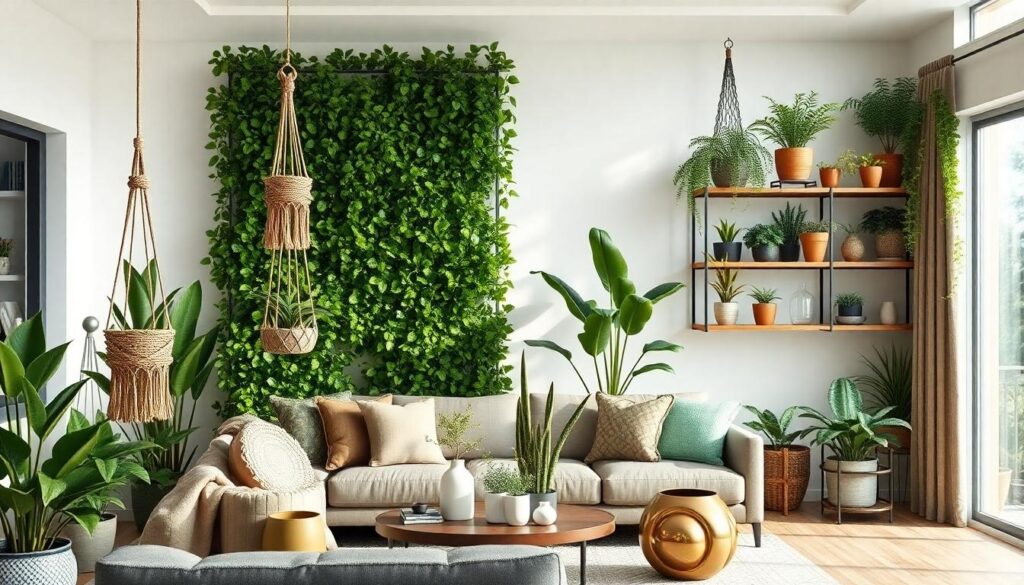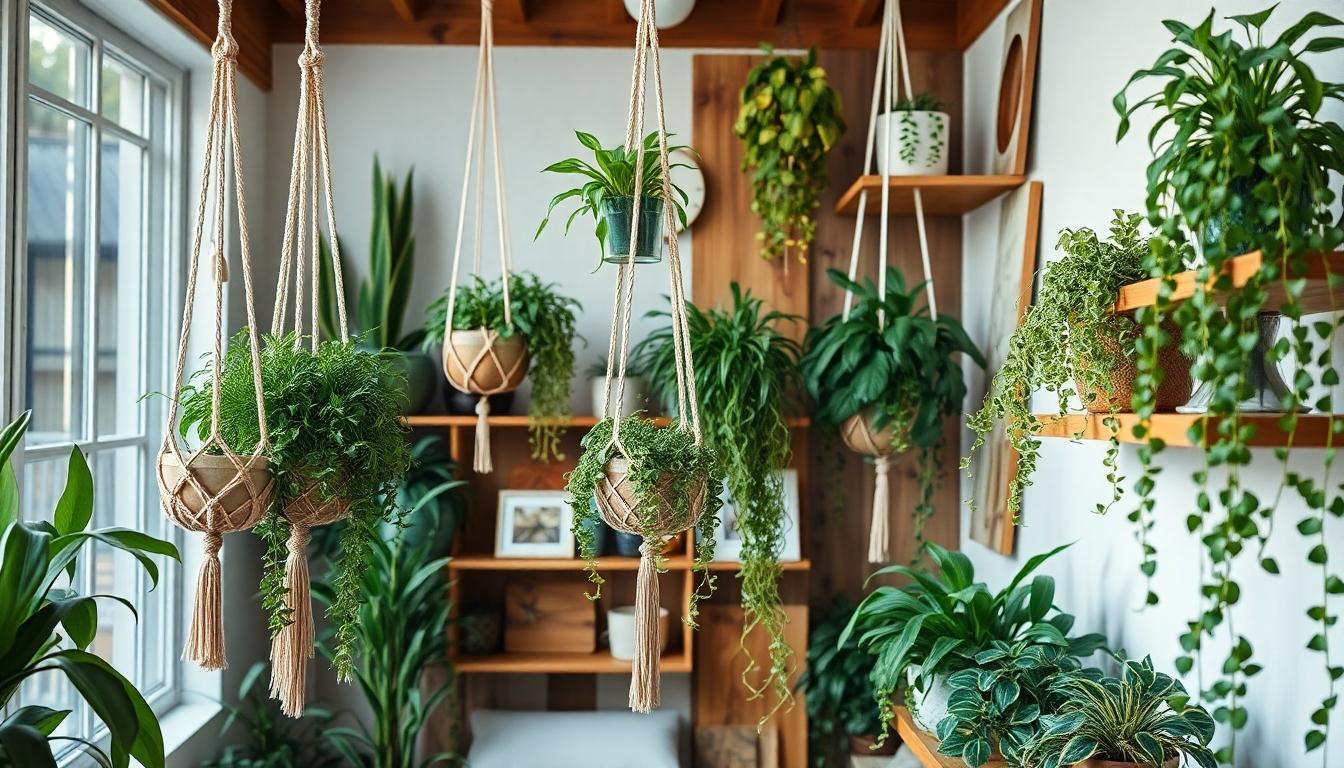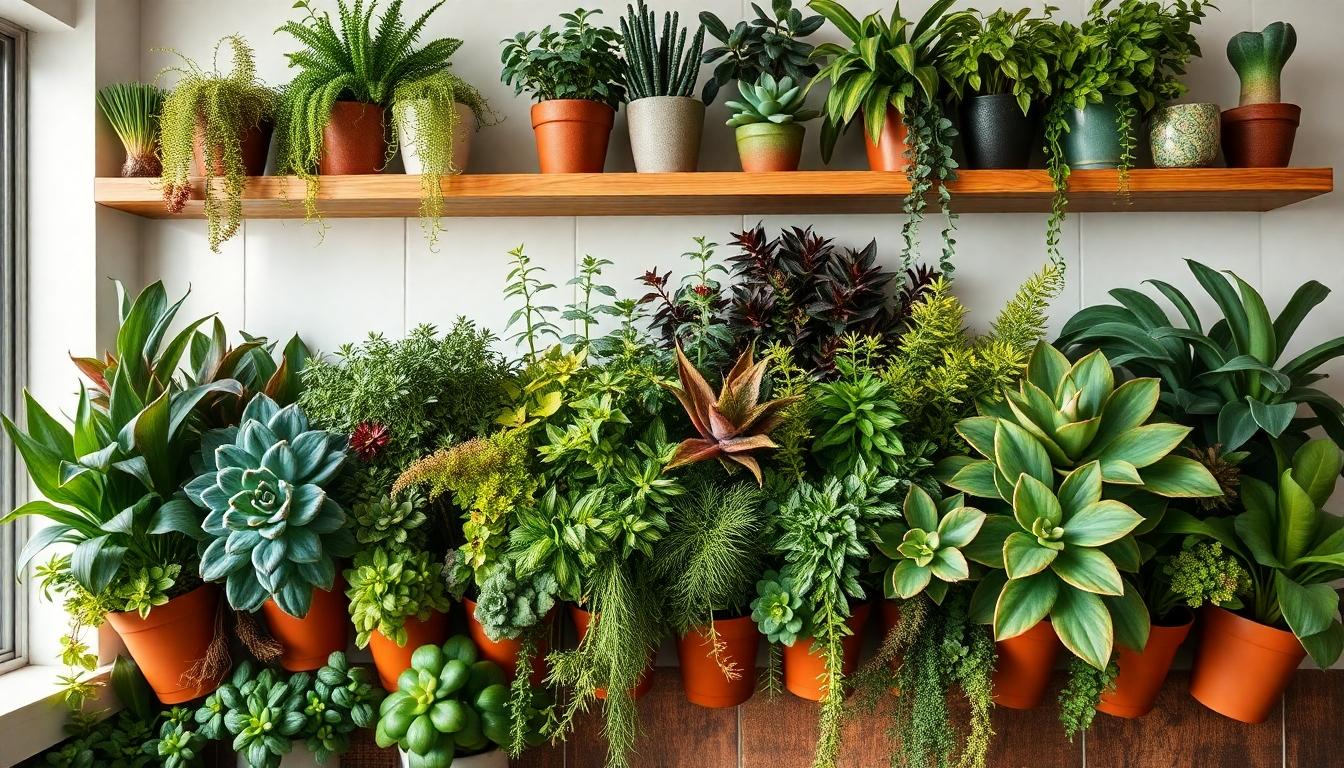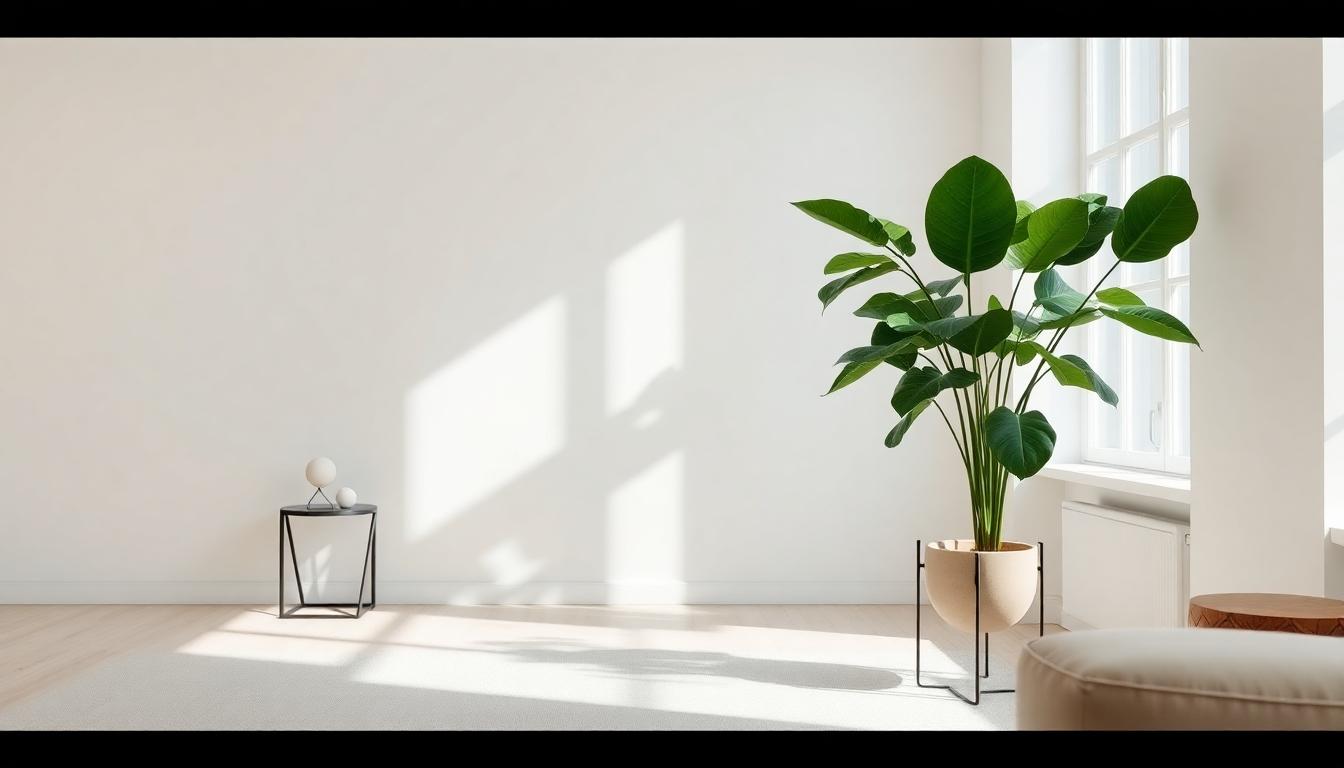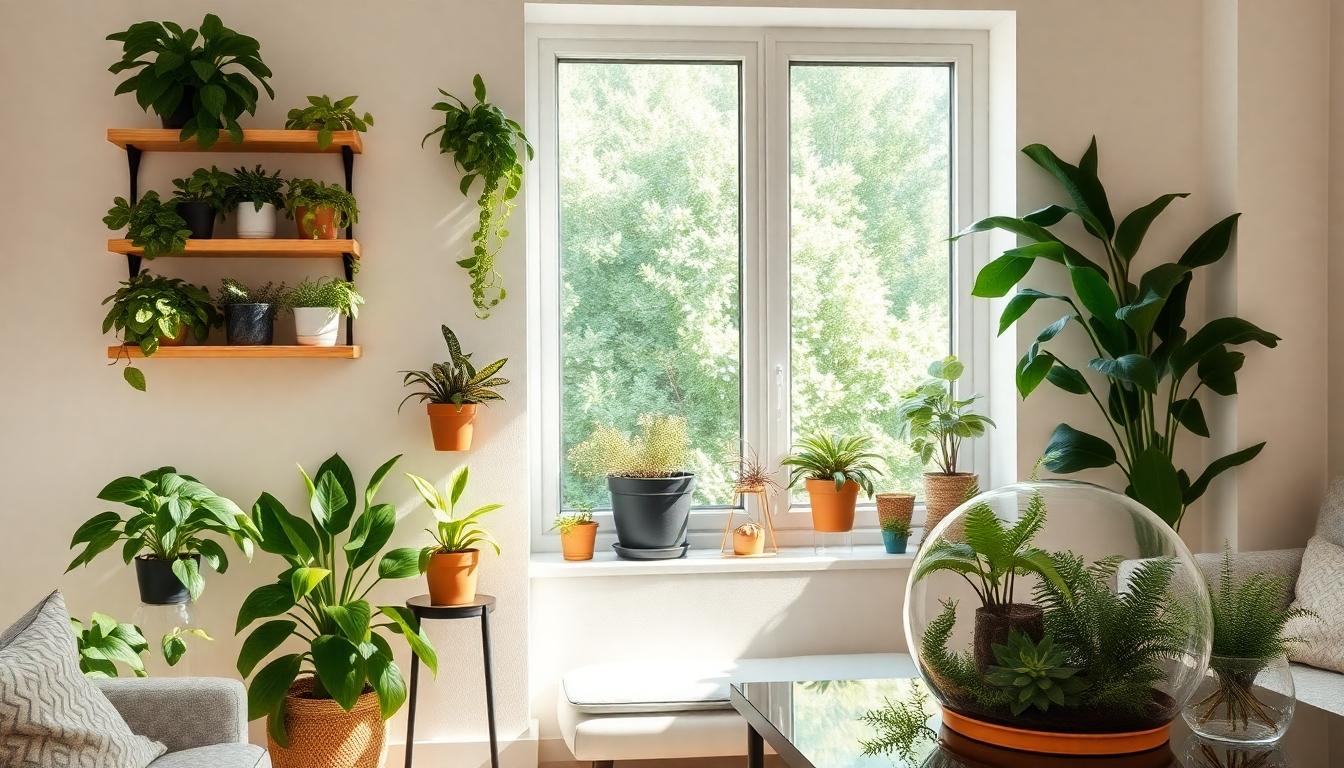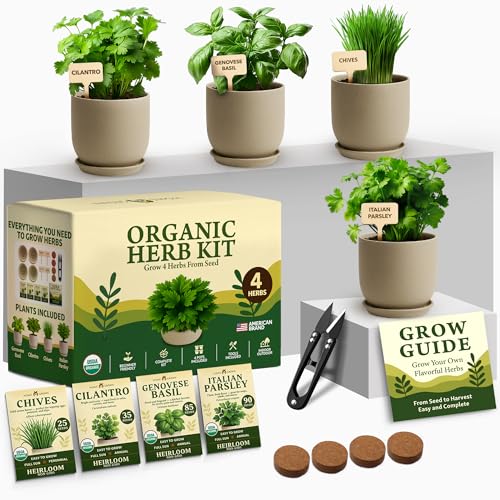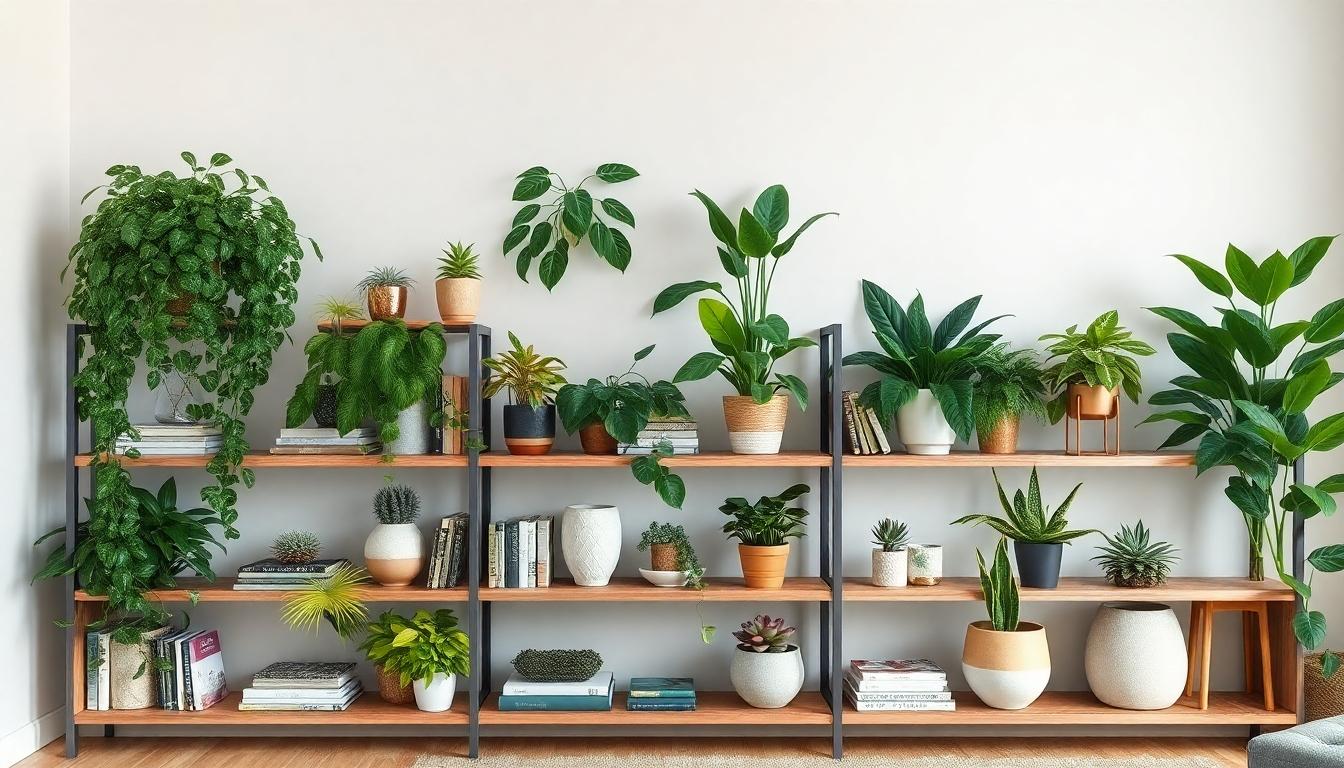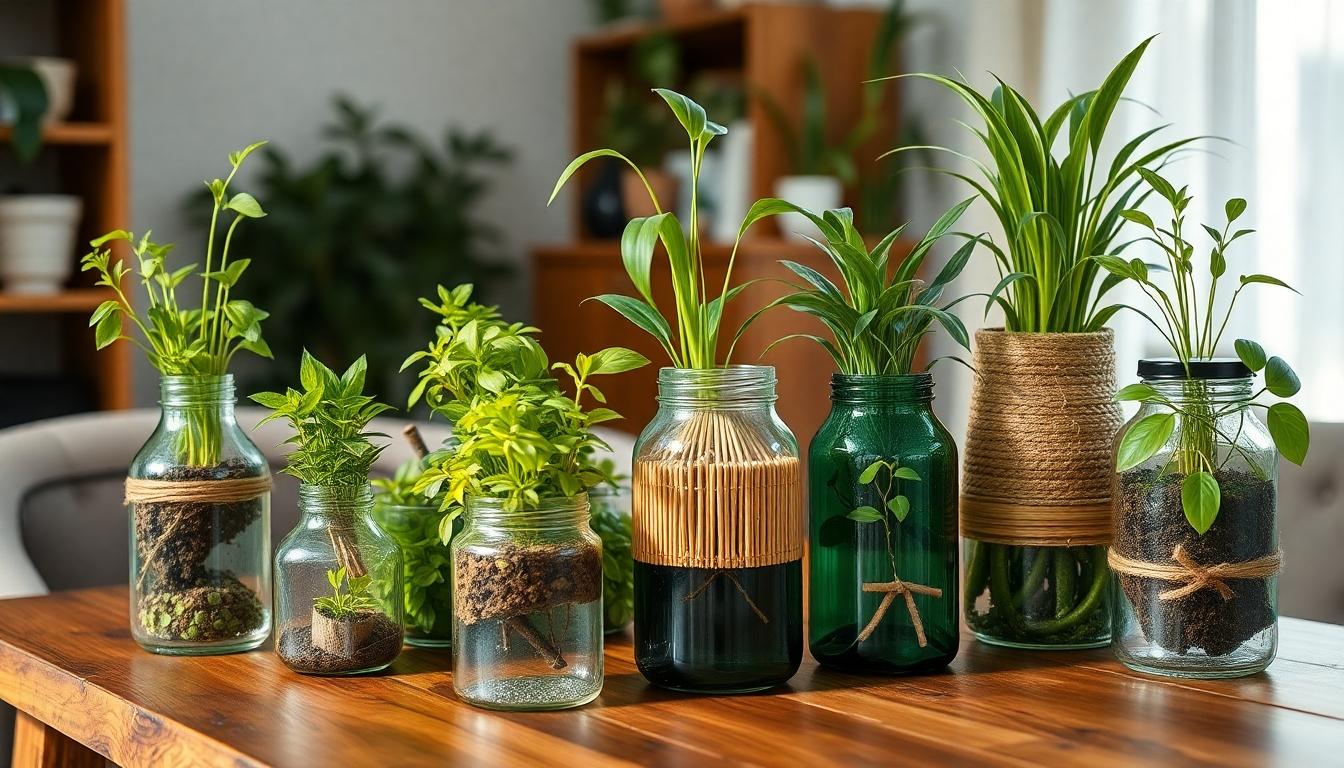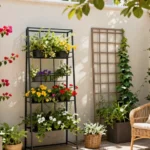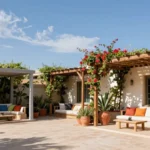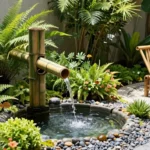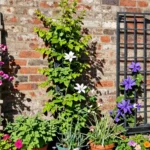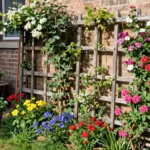Transforming your living space with plant décor isn’t just a trend—it’s a lifestyle change that brings nature’s calming presence indoors. Whether you’re a seasoned plant parent or just starting your green journey, incorporating plants into your home design creates a refreshing atmosphere while purifying the air we breathe.
We’ve gathered the most inspiring plant décor ideas that’ll help you turn any corner of your home into a lush sanctuary. From hanging gardens and statement planters to miniature terrariums and vertical green walls, there’s something for every space and skill level. These versatile décor elements work in any room, adding texture, color, and life to even the most minimal settings.
7 Creative Plant Decor Ideas to Transform Your Living Space
1. Create a Living Wall
Living walls make stunning focal points in any room. You can install a pre-made living wall system or create your own using pocket planters, shelving, or a pegboard with attached pots. Plants like pothos, ferns, and succulents work beautifully in vertical arrangements. These green walls not only save floor space but also dramatically transform bland walls into vibrant, breathing art installations.
2. Design a Plant Shelf Display
Floating shelves offer endless possibilities for creating eye-catching plant displays. Arrange plants of varying heights, textures, and colors to create visual interest. Trailing plants like string of pearls or philodendron work wonderfully on higher shelves, while taller specimens can anchor lower levels. Mix in decorative items like small sculptures, books, or framed photos to create a balanced, personalized display.
3. Hang Macramé Plant Holders
Macramé hangers bring a bohemian touch to your plant decor while drawing the eye upward. These woven holders work particularly well with trailing plants such as spider plants, pothos, or string of hearts. Position them near windows for optimal light or group several at varying heights for a more dramatic effect. Modern macramé designs range from simple and minimalist to intricate and detailed, fitting any decor style.
4. Use Plants as Room Dividers
Larger plants can effectively divide open-concept living spaces without blocking light or airflow. Tall plants like fiddle leaf figs, palms, or bird of paradise create natural partitions between living and dining areas. Place them in decorative pots on plant stands of varying heights to enhance the dividing effect while maintaining an open, airy feel throughout your space.
5. Incorporate Plants Into Bathroom Decor
Bathrooms offer ideal conditions for many humidity-loving plants. Ferns, peace lilies, and orchids thrive in the steamy environment created by showers. Position them on windowsills, floating shelves, or even hanging from shower curtain rods. Small potted plants can also adorn countertops or toilet tanks, bringing life to these often overlooked spaces while benefiting from the naturally humid conditions.
6. Create Themed Plant Corners
Themed plant collections add personality and focus to your decor. Desert corners featuring various cacti and succulents make striking visual statements with minimal care requirements. Tropical themes with lush, broad-leaved plants create mini vacation vibes. Group your themed plants together on a dedicated table, cart, or corner shelf, using complementary pots and accessories to enhance the thematic display.
7. Integrate Plants With Furniture
Furniture-integrated planters offer seamless ways to incorporate greenery into your living space. Coffee tables with built-in planters create conversation pieces in living rooms. Plant stands that double as side tables maximize functionality in small spaces. Under-shelf hanging planters use otherwise wasted space. These dual-purpose pieces blend form and function perfectly, allowing you to add plants even to rooms with limited surface area.
Using Hanging Plants to Maximize Vertical Space
Hanging plants offer an ingenious solution for plant lovers with limited floor space. By utilizing vertical areas, you can transform bare walls and empty corners into lush green displays that add dimension and life to any room.
Macramé Plant Hangers for Bohemian Vibes
Macramé plant hangers bring a perfect blend of texture and bohemian charm to your space while making excellent use of vertical areas. These intricately knotted cotton rope or twine creations suspend your favorite plants from the ceiling, adding visual interest at varying heights. Their distinctive patterns and natural materials complement almost any décor style, from minimalist to eclectic spaces. You’ll find these hangers particularly effective when grouped in clusters of different lengths, creating a ever-changing hanging garden effect that draws the eye upward. Many plant enthusiasts appreciate how macramé holders can be customized with different colors and patterns to match existing décor elements.
Floating Shelves with Trailing Plants
Floating shelves provide a minimalist yet effective platform for displaying cascading greenery along your walls. Installing these sleek shelves at strategic heights allows trailing plants to create living curtains of foliage that soften architectural lines. Ivy, creeping fig, and other plants with long, trailing stems work exceptionally well in this arrangement, their vines gracefully spilling downward to create visual movement. The combination of structured shelving with organic plant forms creates a balanced aesthetic that makes rooms feel more alive and dimensional. Wall-mounted shelving systems also offer flexibility, allowing you to rearrange your plant display as your collection grows or as seasonal light changes affect your plants’ needs.
Creating a Stunning Plant Wall for Visual Impact
Plant walls serve as extraordinary focal points that transform ordinary spaces into vibrant, living showcases. These vertical gardens not only maximize your space but create a stunning visual impact that instantly elevates any room’s aesthetic appeal.
Grid-Style Plant Walls for Modern Spaces
Grid-style plant walls offer perfect symmetry and organization for contemporary interiors, creating a structured yet organic visual statement. Planning your layout on a grid ensures balance and harmony, making this approach ideal when working with green wall panels to avoid common installation mistakes. We recommend combining plants with varying textures and heights within your grid to create depth and dimension. These methodical arrangements work particularly well in minimalist spaces where the orderly pattern provides a satisfying contrast to the natural forms of the plants themselves. For a sleek, modern appearance, consider framing your grid with metal or wood structures that complement your existing décor elements.
Mix-and-Match Plant Wall Arrangements
Mix-and-match plant wall arrangements allow for creative expression through flexible combinations of different plants, containers, and display methods. Tiered wooden shelves provide an excellent foundation for showcasing potted herbs and succulents, making them perfect additions to kitchens or dining areas. Fabric hanging pockets offer space-saving answers that organize your plants while adding visual interest to contemporary spaces. Creating themed plantings can transport visitors to different environments – consider native plant collections, Mediterranean species like lavender and olive trees, or lush tropical specimens such as monstera. Arranging plants in geometric or abstract patterns creates a modern artistic statement that functions as living architecture within your space. The versatility of this approach allows you to express your personal style while accommodating plants with different light and care requirements in appropriate positions within your display.
Incorporating Plants into Minimalist Decor
Adding greenery to minimalist spaces requires careful selection of plants and thoughtful placement to maintain clean aesthetics while bringing nature indoors. Focus on low-maintenance species that offer structural interest without introducing visual clutter.
Single Statement Plants in Neutral Planters
Large, sculptural plants create powerful focal points in minimalist settings without overwhelming the space. Ficus Lyrata (Fiddle Leaf Fig) and Rubber Plants (Ficus Elastica) stand out as perfect specimens for this purpose, offering bold silhouettes with their structured foliage. We recommend pairing these statement plants with neutral-toned containers that complement rather than compete with your plant’s natural beauty. Unglazed ceramic pots in soft whites or grays provide an understated backdrop that enhances the plant’s organic form. Matte terracotta offers a timeless, earthy quality while maintaining visual simplicity. For a contemporary edge, matte-black planters create striking contrast against vibrant greenery. Clear glass vessels showcase the beauty of roots and soil layers, adding subtle interest without breaking your minimalist aesthetic. The right container-plant pairing creates balance between simplicity and natural vitality.
Clean-Lined Plant Stands for Contemporary Homes
Elevating your plants with the right stand enhances their presence while preserving minimalist principles. Geometric or monochrome stands crafted from powder-coated steel bring sleek, contemporary lines to your space. Light wood stands add warmth while maintaining simplicity through clean profiles and natural textures. Concrete pedestals offer industrial appeal with their raw, unadorned surfaces. We suggest tripod stands or floating shelves for adding height variation without visual weight. Wall-mounted planters make excellent use of vertical space, keeping floors clear and uncluttered—a crucial consideration for small apartments or studios. Minimalist hanging systems suspend plants without fussy details, creating dramatic height while preserving your room’s clean aesthetic. The best plant stands feel intentional rather than decorative, functioning as understated platforms that allow your carefully chosen plants to remain the focus within your minimalist home.
Designing with Plants for Small Space Solutions
Small spaces can become verdant havens with strategic plant placement and selection. We’ve gathered innovative answers that maximize greenery while minimizing footprint for apartments, tiny homes, and compact areas.
Vertical Answers for Limited Floor Space
Vertical planters and wall-mounted shelves transform unused wall areas into thriving plant displays without sacrificing precious floor space. Variegated foliage plants like pothos and philodendrons add visual interest through their patterned leaves while maintaining a compact growth habit. Hanging planters featuring trailing species such as spider plants create dimension by drawing the eye upward while softening harsh corners and edges. This vertical approach creates layered greenery that adds depth to small rooms without creating clutter at eye level.
Window Sill Herb Gardens
Window sills offer prime real estate for compact culinary herb gardens that combine functionality with beauty. Basil, thyme, and mint thrive in small pots placed along sunny windowsills, providing fresh flavors within arm’s reach of cooking areas. Repurposed containers like vintage spice jars or colorful teacups create personalized displays while reducing waste. Plants in window gardens require proper drainage holes to prevent root rot, and regular rotation ensures even growth as they reach toward sunlight. This practical approach to small-space gardening delivers aromatic herbs year-round while making use of often overlooked space.
Compact Terrariums for Tiny Spaces
Closed terrariums housed in glass containers like fish bowls or cloches create self-sustaining ecosystems perfect for humidity-loving plants including ferns and mosses. Air plants (Tillandsia) offer exceptional versatility in open terrariums or mounted on driftwood pieces, requiring no soil and minimal space while adding sculptural interest. Miniature succulents and jade plants arranged in shallow dishes provide varied textures and subtle color without demanding important surface area. These miniature landscapes serve as living art pieces that thrive in limited space while requiring minimal maintenance.
Space-Saving Tips and Material Choices
Soilless displays featuring cuttings propagated in water-filled jars deliver a clean, clutter-free aesthetic that showcases plant development. Multi-functional arrangements blend plants with books, photographs, or artwork to enhance small nooks while maximizing available space. Seasonal rotations with temporary blooms like forsythia branches or pansies refresh compact spaces throughout the year without requiring permanent real estate.
For cohesive design impact, uniform-colored planters harmonize with existing room décor while creating visual continuity. Glass containers maintain an airy, lightweight feel in tight spaces, while vintage planters like repurposed berry carriers or decorative tin cans add character and rustic charm. These thoughtful material selections enhance the presence of greenery while complementing established design elements.
Styling Open Shelving with Strategic Plant Placement
Open shelving provides the perfect canvas for showcasing your plant collection while maintaining functional storage space. Strategic placement transforms ordinary shelves into ever-changing displays that bring life and dimension to any room.
For maximum visual impact, arrange plants in clusters of 3-5 on open shelves to create cohesive groupings. Position trailing varieties like pothos or philodendron near shelf edges where they can cascade naturally downward, creating a waterfall effect. Compact plants such as succulents and air plants work perfectly for filling smaller gaps between other items. Always consider light conditions when positioning your plants—place light-loving species on shelves near windows while reserving low-light tolerant varieties like snake plants for shadier spots.
Alternating Plants with Books and Decorative Objects
Balancing greenery with functional decor creates visually interesting shelf arrangements that showcase your personality. Layer plants between books, vases, and ceramics to achieve a harmonious blend that feels both curated and natural. Place shorter plants beside vertically stacked books to create appealing contrast in both texture and form. Geometric pots add a modern touch to organic plant shapes, creating an interesting juxtaposition of elements.
Neutral-toned planters in white or terracotta provide a subtle backdrop that allows colorful books or artwork to shine. Using this alternating approach prevents shelves from feeling monotonous or overcrowded with a single type of item. The combination of living plants with inanimate objects creates rhythm and flow across your shelving unit, drawing the eye naturally across the display.
Creating Height Variation with Different Plant Sizes
Incorporating plants of various heights establishes a sense of depth and dimension that makes shelf displays more visually compelling. Tall statement plants like snake plants, fiddle-leaf figs, or majesty palms add dramatic vertical interest that immediately draws attention. Pairing these taller specimens with mid-height plants such as rubber plants and ZZ plants creates a tiered effect that feels intentionally designed.
Low-profile succulents can occupy the foreground, completing the layered look with their compact form. For shelving units specifically, mix hanging planters with small potted herbs and trailing varieties to enhance dimensional flow from top to bottom. The varied heights create natural focal points while maximizing the visual impact of your plant collection.
When selecting containers, match pot materials to your room’s existing aesthetic—ceramic vessels for modern spaces or woven baskets for bohemian interiors. Consider safety by keeping toxic plants elevated if pets or children are present. Lazy Susans provide a practical solution for easy plant maintenance and ensuring even sun exposure for shelf-dwelling plants that might otherwise receive uneven light.
Adding Personality with Unique Planters and Containers
The containers you choose for your plants can be just as expressive as the plants themselves. Unique planters add character and style to your green collection while reflecting your personal taste and environmental values.
Upcycled Containers as Eco-Friendly Planters
Transforming everyday items into planters offers a sustainable way to showcase your plants while reducing waste. Glass bottles, plastic containers, and coconut shells make excellent upcycled planters that contribute to eco-friendly home décor. Agricultural by-products provide another sustainable option, with planters crafted from bamboo fiber, wheat husk, and coffee bean husk offering environmentally responsible alternatives that don’t sacrifice style. These natural materials are typically finished with non-toxic resins, making them safe for both your plants and home environment.
Biodegradable materials like cardboard tubes from toilet paper rolls serve as perfect mini planters for growing seedlings. We love how these eco-friendly options can be planted directly into garden soil, eliminating the transplanting step while reducing waste. Recycled plastic planters represent another sustainable choice that helps decrease plastic pollution while providing durable, weather-resistant homes for your plants.
Statement Ceramic and Metallic Planters
Ceramic planters bring artistic expression to plant displays with their wide variety of designs, colors, and patterns. These versatile containers range from traditional terracotta to intricate hand-painted pieces that become art objects in their own right. Available in both classic and contemporary styles, ceramic planters can complement any interior design scheme while providing excellent homes for your plants.
Metallic planters add a touch of sophistication and industrial chic to any space. Brass and copper containers develop beautiful patinas over time, creating living finishes that evolve alongside your plants. These striking planters work particularly well as focal points in minimalist spaces, where their reflective surfaces and clean lines create dramatic contrast with organic plant forms. Metallic options can anchor larger statement plants or create stunning visual interest when grouped in collections of varying heights and sizes.
Seasonal Plant Decor Ideas for Year-Round Interest
Bringing plants into your home isn’t just a design choice—it’s a lifestyle transformation that connects us with nature daily. We’ve explored countless ways to incorporate greenery from stunning living walls to space-saving answers for small apartments.
Remember that plants are ever-changing elements that evolve with care and time. The perfect arrangement balances aesthetic appeal with practical maintenance while expressing your personal style.
Whether you’re drawn to minimalist displays with sculptural specimens or lush botanical collections in unique containers let your plant decor evolve with the seasons and your growing confidence as a plant parent.
Start with one idea that resonates with you and watch as your connection to nature—and your home’s beauty—flourishes with each new leaf and bloom.
Frequently Asked Questions
What are the benefits of incorporating plants into home décor?
Plants do more than just look pretty – they create a calming atmosphere, improve air quality, and add life to your space. These natural elements bring texture, color, and vitality to any room while promoting a healthier living environment. Incorporating plants is a meaningful lifestyle change that transforms your home beyond just following a decorating trend.
How can I create a plant wall in my home?
Create a stunning plant wall by using grid-style systems for modern spaces or mix-and-match arrangements for creative expression. Combine plants with varying textures and heights for depth. Options include tiered wooden shelves, fabric hanging pockets, or dedicated wall-mounting systems. Ensure plants receive appropriate light and consider maintenance access before installation.
What plant décor works best for minimalist spaces?
Choose large, sculptural plants like Ficus Lyrata or Rubber Plants in neutral planters to create focal points without clutter. Opt for clean-lined plant stands in geometric shapes, monochrome designs, or light wood. Wall-mounted planters and minimalist hanging systems utilize vertical space while keeping floors clear, maintaining the essential minimalist principle of simplicity.
How can I incorporate plants in a small apartment?
Maximize vertical space with wall-mounted shelves and hanging planters. Create window sill herb gardens with compact pots. Use small terrariums for humidity-loving plants that create self-sustaining ecosystems. Choose trailing plants like pothos that provide significant visual impact without taking up floor space. Stick to uniform-colored planters to maintain visual cohesion.
What are creative ways to display hanging plants?
Use macramé plant hangers to add texture and bohemian charm while suspending plants at varying heights. Install floating shelves as minimalist options for showcasing trailing plants. Hang plants in clusters near windows for maximum light exposure and visual impact. Consider ceiling hooks, tension rods, or wall brackets to create dynamic arrangements that draw the eye upward.
How should I style open shelving with plants?
Create clusters of 3-5 plants for visual impact and balance them with books and decorative objects. Vary the heights of plants to create visual interest and rhythm across the shelving. Position light-loving varieties on upper shelves and shade-tolerant plants below. Choose containers that complement your room’s color scheme and consider the weight capacity of your shelves.
What types of unique planters can enhance my plant display?
Explore eco-friendly options like upcycled containers from everyday items or biodegradable materials. Consider statement ceramic planters ranging from traditional to contemporary designs that add artistic expression. Metallic planters in brass, copper, or gold finishes add sophistication and reflect light beautifully. Match container styles to your interior design for a cohesive look.
How can plants be used as room dividers?
Large floor plants like fiddle leaf figs, palms, or bamboo create natural boundaries between spaces without blocking light. Arrange several medium-sized plants in a row to define areas like dining and living spaces. Use hanging plants suspended from ceiling tracks or tension rods to create semi-transparent divisions. This approach maintains airflow while providing visual separation in open-concept homes.

